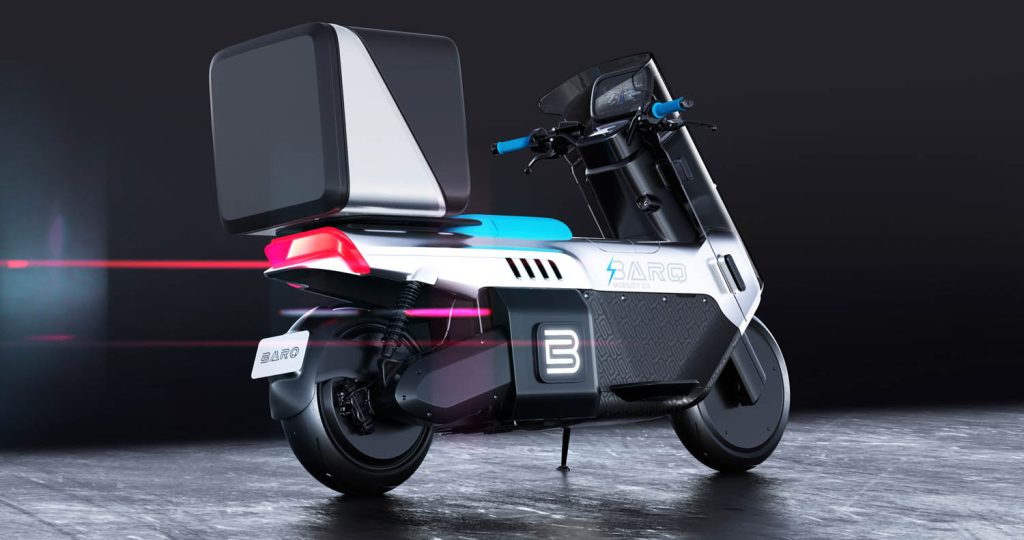Rena Max – With the rise in demand for last-mile food delivery across MENA countries, mobility start-up Barq and Callum Design developed a new electric scooter that aims to address the region’s specific needs
Challenged with the unique terrain and range requirements of the Middle East and North Africa (MENA) market, Dubai-based e-mobility start-up Barq turned to Callum Design to address the rise in demand for last-mile deliveries.
MENA regions have seen demand for local delivery of food, products and services soar, while a push for sustainable power and rider comfort meant Barq had a number of requirements in mind for a new delivery scooter.
Developed in collaboration with leading MENA restaurant company Americana and delivery platform Jahez, the Rena Max has been designed to meet the region’s needs.
The design team at Callum added features to cope with the configuration of cities and the hot weather in MENA regions. For example, the handlebar grips are made in light blue polyurethane and the seat has a diamante textured in vinyl blue, both designed to be cooler to the touch.
The tubeless 13-inch and 14-inch tyres are designed to minimise punctures, even on unpaved roads. To improve the level of security for unattended vehicles during drop-offs, Callum introduced an electronically controlled locking system log that tracks all openings of the backbox.
The vehicle also features 5.6KwH swappable lithium-ion battery technology, to avoid lengthy charging times and offer a range of up to 150km, powered by a 7KW motor.
“Another key aspect was the rider experience,” says Callum head of creative, Aleck Jones. “Barq has done a lot of research into riders’ needs. The brief was to ensure the utmost functionality, comfort and convenience for users.”
For example, Barq’s user experience research suggested that, in most typical scooters, there is no room to carry a drinks bottle, which means drivers need to stop more often and can even get dehydrated while working. With that in mind, Callum introduced a large storage area where riders can fit a two-litre bottle and some belongings.
The Rena Max features further storage areas, a 79-litre box behind the driver with adjustable shelving and passive insulation with a food-safe lining, plus a 5-litre and a 9-litre box at the front.
“Unconstrained, we had the opportunity to create a modern, functional and intelligent design,” says Jones.
Rena Max – the road ahead
Another example is the 8-inch Samsung Galaxy Tab Active3 touchscreen: “Riders usually get their route information on a handheld device. That’s neither easy to follow nor glance at. It led us to prioritise the touchscreen in the dash layout with a specified mounting angle that minimises glare and reflections,” says Jones.
Barq and Callum collaborated in the development of the design all through the process: “We started with dozens of initial 2D themes and then with the Barq team picked two to develop further into 3D,” says Jones.
“Then we presented both, and ultimately chose a final theme to begin realising the finished product. This led to further collaborative design stages with the engineering team to help make the vision a reality.”
The design team used the Autodesk design suite of tools, including Alias and VRED, for the initial 3D design work, creating the visuals for virtual reality design reviews with Barq, before developing the scooter’s surfacing.
The design process moved into Catia, which was used to create the 3D CAD model for engineering and manufacturing.
To test the seating arrangement, the Callum design team created in-house bucks and had riders and nonriders of all shapes and sizes come in to test them.
A MakerBot 3D printer was employed for trialling design ideas, including a full-scale mock-up design model used for the presentation and launch of Rena Max. “Callum is about creating bespoke solutions that are a potent blend of design and engineering expertise,” says Ian Callum, who oversaw the Barq project with the growing Callum team at its headquarters in Warwick. “Rena Max has a sense of style that is sometimes forgotten with future mobility solutions.”
Adds Jones: “I wanted to make sure that the innovations we introduced added something to its value and user experience. I didn’t want anything to be just for the sake of it or just to look good, but to have a function and be an improvement on what else is out there. The feedback suggests that we have achieved this.”
The next stage for the start-up is to further test develop the Rena Max using simulation, before manufacturing and final delivery.








